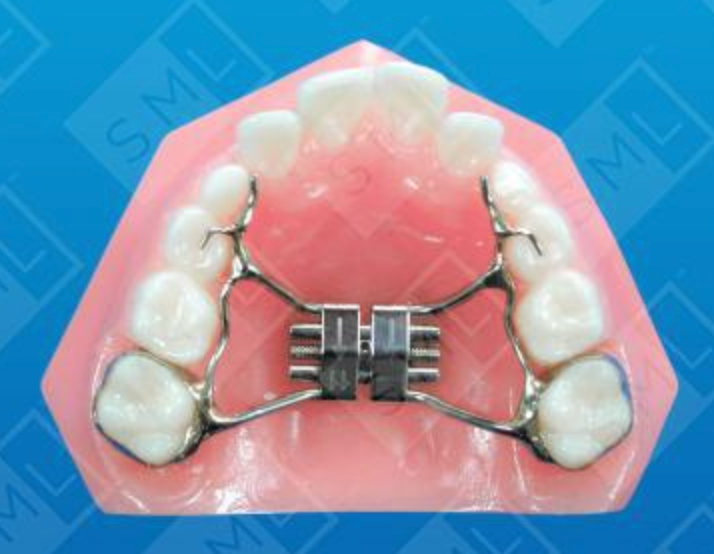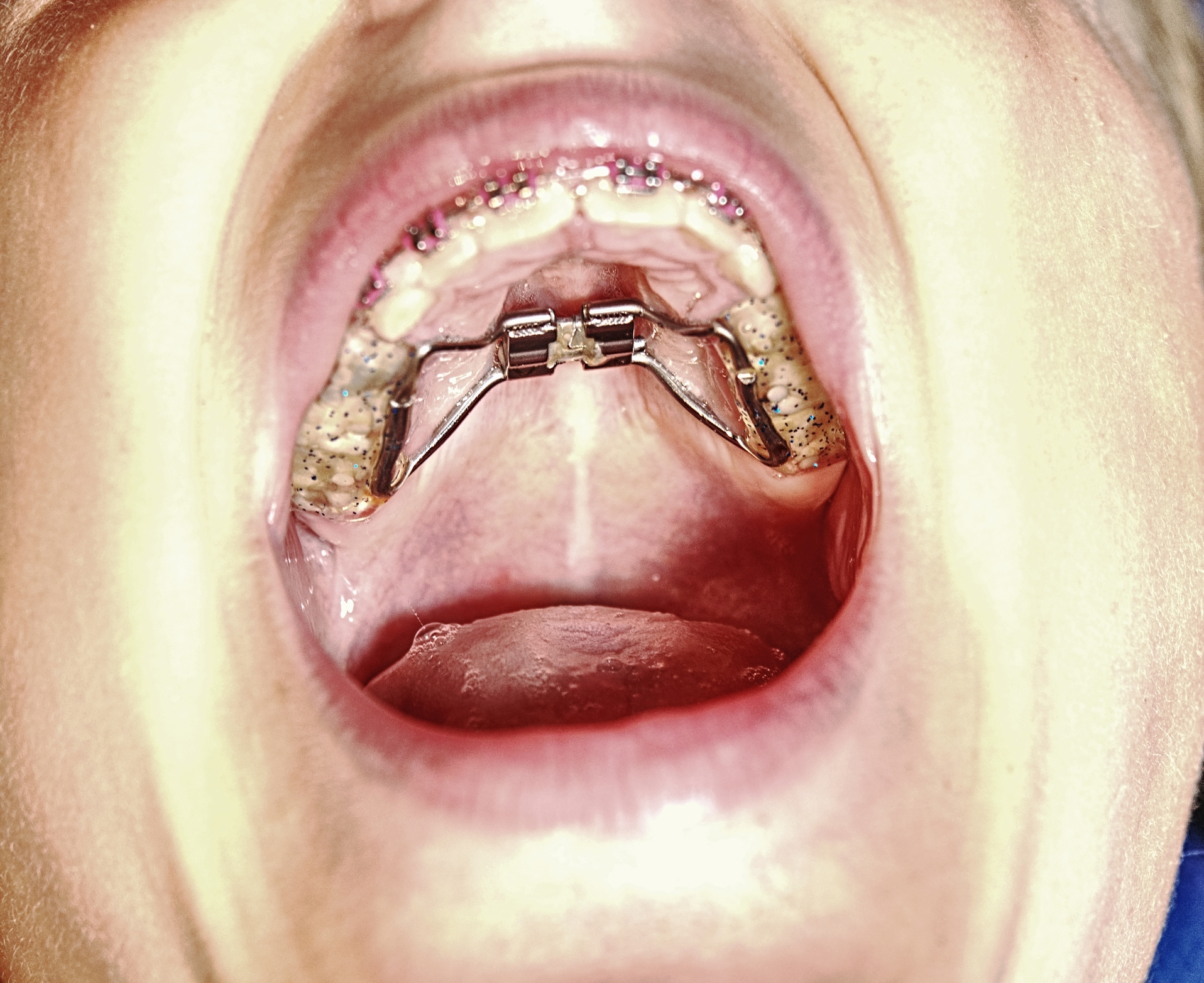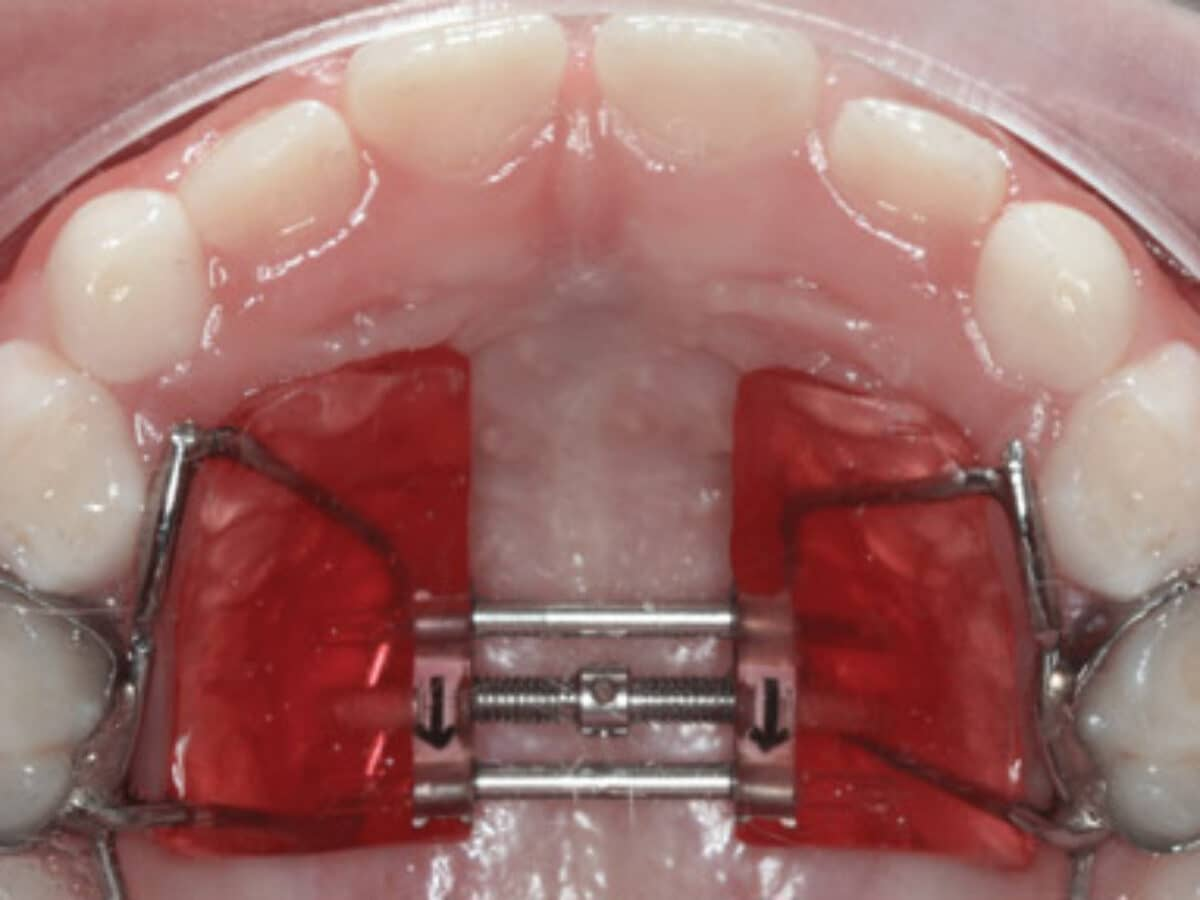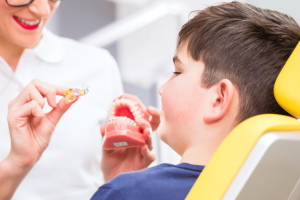The Palatal Expander Explained
The world of orthodontics, with its intricate appliances and specialized procedures, can often seem like a labyrinth for parents seeking the best care for their children.
Among the various orthodontic devices available, the rapid palatal expander stands out as a crucial tool in treating children.
This article aims to demystify palate expanders, including the rapid palatal expander (RPE), and explain how these devices are used in pediatric orthodontic care.
Who Should Get a Rapid Palatal Expander?
Palatal expanders work best in young growing children. It is an early age compared to braces.
When a child has been identified as having a narrow or small upper jaw and they are 6-10 years old, we often talk to the parents about using palatal expansion (maxillary expansion) to make room for the upper teeth or change the way the teeth bite together.
These children often have overcrowded teeth, are in the mixed dentition (some baby and some grown-up teeth), and have a posterior crossbite.
The timing of palatal expansion is important. The mid palatal suture (the centre of the upper jaw) can only be moved to create the desired width and space before it fuses.
This generally means before age 12 in girls (ideally before 10) and before age 14 (ideally before 12) in boys.
The mid palatal suture closes (fuses) during puberty and the age this occurs varies widely among the population.
This is why we recommend every child see an orthodontist at the age of 7.
Understanding Palatal Expanders
What Is a Palate Expander?
A dental expander, also known as a palate expander, or a maxillary expander, is an orthodontic device designed to widen the upper jaw (maxilla) in children.
The goal of a palatal expander is to make the upper jaw wider which makes space for upper teeth and changes how the teeth bite together.
The maxilla is composed of two halves of bone joined by a suture, which does not fully fuse until late adolescence. This unique developmental window allows orthodontists to use palate expanders to create additional space and width in a child’s mouth before the suture closes fully.
Types of Palate Expanders
There are several types of palate expanders, each designed to address specific orthodontic needs:
- Fixed Palate Expanders:
- Hyrax Expander: A common fixed expander that uses an expansion screw mechanism to gradually widen the palate. It is attached to the molars on the upper jaw and can be used for rapid palatal expansion.
- Haas Expander: Similar to the Hyrax but includes acrylic pads that press against the roof of the mouth. The Haas expander is often used for rapid palatal expansion in older children and teens when holding on to the teeth alone does not provide enough support.
- Removable Palate Expanders:
- Typically used for less severe cases and can be taken out for cleaning and eating. For a palatal expander that can be removed to be effective, it must be worn for 22 hours a day.
- Rapid Palatal Expanders (RPE):
- A type of fixed expander that works quickly to separate the two halves of the maxilla. An RPE is often called an RME for rapid maxillary expansion. This technique is advocated for any patient that has not yet gone through puberty.
How Does a Rapid Palatal Expander Work?
The RPE is a device used for maxillary expansion (skeletal expansion), attached to the upper molars using bonding or cemented bands. It features a tiny screw that can be turned incrementally each day.
This gradual expansion technique applies gentle pressure on the midpalatal sutures, encouraging the two halves of the maxilla to move apart and widen the upper jaw.
Understanding the Biology Behind Rapid Palatal Expanders
The mechanics of a rapid palatal expander (RPE) are fascinating and rooted in the biology of craniofacial development. To fully appreciate how an RPE functions, it’s essential to delve into the anatomical structures it influences, particularly the palatal bones, and the biological processes it leverages.
Anatomy of the Maxilla
The maxilla, or upper jaw, plays a crucial role in both dental alignment and facial aesthetics. It is composed of two halves joined at the midline by a suture known as the mid palatal suture.
This suture is a fibrous joint that remains flexible and malleable in children and adolescents.
Over time, typically during late adolescence, this suture begins to ossify, or harden, and the two halves of the maxilla fuse together permanently.
By the time children are young adults, the two bones of the upper jaw have become one and an oral surgeon would be needed to achieve maxillary expansion.
The Role of the Midpalatal Suture
In young patients, the midpalatal suture is not yet fused, allowing for orthodontic appliances to intervene to modify the width of the palate through palatal expansion. The primary goal of the RPE is to exploit this period of skeletal plasticity.
How the RPE Works:
- Attachment to Upper Molars:
- The RPE is firmly anchored to the upper molars using bonding agents or cemented bands. We call this being tooth borne. These molars are adult teeth and serve as stable points for applying force using an expansion technique.
- Central Screw Mechanism:
- The heart of the RPE is its central expansion screw. The use of these mini screws, when turned incrementally (usually with a special key provided by the orthodontist), exerts outward force on both sides of the maxilla. Most children do not experience pain and only report minor discomfort in the first few days while getting used to the orthodontic appliances.
- Gradual Adjustment and Force Distribution:
- Each turn of the screw widens the expander slightly, typically by 0.25 mm per day. This gradual adjustment applies sustained pressure on the midpalatal suture. Your orthodontist will tell you how many turns you need to do to increase the arch perimeter by the correct amount to get the desired width.
Biological Response to Expansion
The body’s response to the forces applied by the rapid palatal expander involves significant skeletal and dental changes, which are a complex interplay of mechanical and biological processes.
Mechanical Forces:
The outward force exerted by the rapid palatal expander during rapid maxillary expansion encourages the two halves of the maxilla to move apart. This movement is facilitated by the elasticity of the midpalatal suture and the surrounding bone structures.
Bone Remodeling:
When the upper jaw (maxilla) gets bigger, the body starts a natural process called bone remodeling. This means that the two bones in the roof of the mouth slowly move apart. Special cells called osteoclasts break down old bone at the edges where the bones meet. At the same time, other cells called osteoblasts create new bone in the space that’s made by the expansion.
This process helps make sure that the bigger upper jaw is supported by strong bone, keeping the jaw stable and strong.
Clinical Phases of Palatal Expander Treatment
Active Phase:
The active phase involves the daily turning of the screw on the rapid palate expander to achieve the desired expansion. This phase typically lasts from a few weeks to a few months, depending on the extent of expansion needed.
During this phase, patients may notice a slight gap forming between their front teeth (diastema). This is a normal and temporary effect as the maxilla widens.
Space is made for crooked teeth to begin to straighten on their own.
Retention Phase:
After achieving the desired expansion with a rapid palate expander, the palatal expander remains in place for several months to allow for bone consolidation. This is when the two palatal bones are growing so that bone fills the gap that was formed.
This retention phase is crucial for stabilizing the newly widened maxilla and ensuring that new bone forms adequately in the expanded area.
The retention period allows the body to complete the bone remodeling process. The bone regenerates, solidifying the changes made during the active phase.
Benefits of a Rapid Palatal Expander
Creating Space:
By widening the upper arch, the rapid palate expander will create space for permanent teeth to erupt correctly, reducing the risk of crowding and misalignment.
This can mean there will be enough room for the anterior or posterior teeth to grow into the mouth.
Improving Bite Alignment:
Correcting issues such as crossbites (anterior crossbites or posterior crossbites), where the upper teeth bite inside the lower teeth, improves overall bite alignment and function.
These are the skeletal effects, as the expander is actually changing the bone in the mouth.
Enhancing Aesthetics:
The expansion of the upper arch can also improve facial symmetry and aesthetics, contributing to a more balanced and attractive appearance.
When a posterior crossbite, as an example, is left untreated, the lower jaw can begin to grow off to one side. This can cause dental and functional issues.
Potential Challenges and Side Effects Of A Palate Expander
While the benefits of palatal expansion are significant, there are some potential challenges and side effects to be aware of:
Discomfort:
- Initial discomfort or pressure is common as the jaw adjusts to the expander. This discomfort typically subsides within a few days.
- Over-the-counter pain relievers can help manage any initial pain or discomfort.
- Our practice provides all patients with a dental pain eraser so that they can have less pain. It often means none at all!
Speech and Eating Difficulties:
- Children may experience temporary changes in speech and difficulty eating certain foods. Soft foods and patience are key during this adjustment period.
- We recommend reading books out loud and taking smaller bites of food for the first few days.
Oral Hygiene:
- Maintaining oral hygiene can be challenging with an hyrax expander or haas expander in place. It’s important to follow the orthodontist’s instructions for cleaning around the device to prevent plaque buildup and dental issues.
The Process of Using a Palatal Expander
Initial Consultation
The journey with a palate expander begins with an initial consultation with an orthodontist to discuss rapid palatal expansion. During this visit, the orthodontist will:
- Conduct a Thorough Examination:
- Examine your child’s mouth, teeth, and jaw structure.
- Take X-rays and impressions to assess the need for a palate expander.
- Discuss Treatment Options:
- Explain the different types of palate expanders and recommend the most suitable option based on your child’s specific needs.
- Discuss the treatment plan, including the duration and expected outcomes.
Installation and Adjustment
Once the decision is made to use a palate expander, the installation process involves:
- Fitting the Expander:
- The orthodontist will attach the expander to the upper molars using bonding or cemented bands.
- Ensure the expander fits comfortably and securely in your child’s mouth after it is fully inserted.
- Instruction on Adjustments:
- Provide instructions on how to turn the expansion screw daily, if applicable, to achieve the desired expansion.
- Schedule regular follow-up visits to monitor progress and make necessary adjustments.
Monitoring Progress
Monitoring the progress of the palate expander is crucial to ensure effective treatment:
- Regular Check-Ups:
- Regular visits to the orthodontist allow for adjustments and ensure the expander is working correctly.
- The orthodontist will check for signs of discomfort or issues and address them promptly.
- Parental Involvement:
- Parents play a vital role in observing changes in their child’s oral health and reporting any concerns to the orthodontist.
- We always ask that if the special key is lost or the palate expander comes loose, you let us know right away.
- Encourage good oral hygiene practices, including brushing and flossing, to maintain dental health during treatment.
- It can be difficult to clean around a palatal expander, so parental help will be needed.
Long-Term Benefits of Palate Expanders
Preventing More Invasive Treatments
One of the primary benefits of using a palate expander through maxillary expansion is preventing more invasive treatments in the future. The early intervention provided by rapid palatal expanders (RPEs) can significantly reduce the need for complex procedures later in life.
Avoiding Tooth Extractions
- Creating Space: By creating sufficient space in the upper jaw, a palate expander can reduce the likelihood of needing tooth extractions (removal) to accommodate adult teeth. This is particularly important for children with narrow palates or crowded teeth, where the lack of space might otherwise necessitate the removal of one or more teeth.
- Promoting Natural Eruption: When there is adequate space in the jaw, permanent teeth can erupt naturally and align correctly without the need for extractions. This not only preserves the natural tooth structure but also maintains the dental arch’s integrity.
- Reducing Trauma: Tooth extractions can be stressful and traumatic for children. By avoiding this procedure through the use of a palate expander, children can experience a less invasive and more comfortable orthodontic treatment process.
Reducing the Need for Surgery
- Early Correction of Misalignments: Early intervention with a palate expander can minimize the need for surgical interventions later in life to correct severe jaw misalignments. Addressing these issues while the jaw is still developing allows for non-surgical correction through slow expansion.
- Preventing Severe Orthognathic Issues: Without early orthodontic treatment, severe orthognathic (jaw-related) issues might develop, requiring corrective jaw surgery in adulthood. Using rapid maxillary expansion during childhood can prevent these complications by ensuring the proper development of the jaw and teeth alignment.
- Cost Effectiveness: Surgical procedures are often more costly and involve longer recovery times compared to the utilization of a palate expander. Investing in early orthodontic intervention can result in significant cost savings and a more straightforward treatment path.
Improving Overall Oral Health
Palate expanders contribute to improved oral health in several ways through maxillary expansion. This impact extends beyond just the aesthetics of a smile to encompass comprehensive dental health benefits.
Enhanced Dental Hygiene
- Easier Cleaning: A wider palate makes it easier to clean between teeth, reducing the risk of cavities and gum disease. When teeth are properly spaced, it is simpler to reach all surfaces with a toothbrush and floss, thus enhancing daily oral hygiene practices.
- Prevention of Plaque Build-Up: Proper alignment of teeth promotes better oral hygiene practices by preventing areas where plaque can accumulate. Misaligned teeth often have nooks and crannies that are difficult to clean, leading to potential decay and gum disease.
- Long-Term Oral Health: Improved hygiene reduces the risk of long-term dental issues such as periodontitis (advanced gum disease) and other serious conditions. By starting with a healthy, well-aligned mouth, children are set up for a lifetime of better oral health.
Alleviating Jaw Pain
- Correcting Malocclusions: Correcting bite alignment issues can alleviate jaw pain and discomfort associated with malocclusions. Malocclusions, or improper bites, can lead to strain on the jaw muscles and joints, resulting in chronic pain and discomfort.
- Reducing Teeth Grinding: Proper alignment can reduce the likelihood of bruxism (teeth grinding), which often exacerbates jaw pain and can cause additional dental damage.
- Improving Functionality: By aligning the teeth and jaws correctly, a palate expander improves bite functionality, making chewing and speaking more comfortable and efficient. This enhancement in functionality can reduce the strain on jaw muscles and joints.
Boosting Self-Confidence
Addressing orthodontic issues early can have a profound impact on a child’s self-confidence.
The psychological and social benefits of having a well-aligned smile should not be underestimated.
Improved Aesthetics
- Enhanced Smile: Achieving proper alignment of teeth and jaws enhances the child’s smile and facial appearance. A straighter, more uniform smile is often perceived as more attractive and can significantly boost a child’s confidence.
- Balanced Facial Structure: Proper jaw alignment contributes to a more balanced facial structure, improving overall facial aesthetics. This balance can enhance how a child feels about their appearance, leading to greater self-assurance.
- Positive Social Interactions: A confident smile can make social interactions more positive and enjoyable. Children who feel good about their appearance are likely to engage more openly and assertively with peers and adults.
Positive Psychological Impact
- Building Self-Esteem: Addressing orthodontic concerns can lead to a more positive outlook on oral health and overall well-being. Knowing that their dental issues are being managed effectively can give children a sense of control and pride in their appearance.
- Reducing Anxiety: Alleviating the stress and embarrassment associated with misaligned teeth can reduce anxiety and improve mental health. Children who are less anxious about their appearance are more likely to participate in social and academic activities.
- Encouraging Healthy Habits: Early orthodontic intervention fosters a lifelong awareness of dental health and encourages the development of healthy habits. Children who experience the benefits of good oral health are more likely to continue these practices into adulthood, contributing to overall well-being.
By understanding and expanding upon these long-term benefits, parents can make informed decisions about their child’s orthodontic care. Rapid palatal expanders offer a range of advantages that extend well beyond the immediate treatment phase, setting the foundation for a lifetime of improved oral health and self-confidence.
Educating the Child
Parents play a crucial role in educating their child about the importance of orthodontic care:
- Explaining the Process:
- Help the child understand why they need a palate expander and how it works.
- Reassure them about the benefits and address any fears or concerns.
- Establishing Good Habits:
- Encourage consistent oral hygiene practices, including brushing and flossing.
- Monitor the child’s diet and avoid foods that may damage the expander.
Providing Emotional Support
Emotional support from parents is essential during orthodontic treatment:
- Addressing Discomfort:
- Offer comfort and reassurance during periods of discomfort or adjustment.
- Provide soft foods and over-the-counter pain relief as needed.
- Celebrating Milestones:
- Celebrate milestones and progress in the treatment journey to boost the child’s morale.
- Reinforce the positive outcomes and benefits of the treatment.
Communicating with the Orthodontist
Maintaining open communication with the orthodontist ensures successful treatment:
- Regular Updates:
- Share observations and updates on the child’s progress during follow-up visits.
- Report any issues or concerns promptly to the orthodontist.
- Adhering to Instructions:
- Follow the orthodontist’s instructions for adjustments and maintenance.
- Ensure the child attends all scheduled appointments for monitoring and adjustments.
Conclusion
Palate expanders (palatal expanders, rapid palatal expanders) are valuable tools in orthodontic care for children with narrow or crowded upper jaws.
By gradually widening the maxilla before it fully fuses, these devices can prevent more invasive treatments and create adequate space for permanent teeth to erupt properly.
If you believe your child may benefit from palatal expansion, consult with an experienced orthodontist (like us) who can assess your child’s specific needs and provide appropriate treatment.
Remember that early intervention with orthodontic care can lead to better outcomes in your child’s oral health journey.
Why Choose Us?
Rapid maxillary expansion technique using a palatal expander (palate expander) is one of the best ways to create space for crowded teeth and fix the way posterior teeth bite together.
Our orthodontists are dedicated to getting the best results for your child.
Come in for a free new patient exam today to see what makes us different!
You can call 403-256-7797 or book online.
We can’t wait to meet you!















